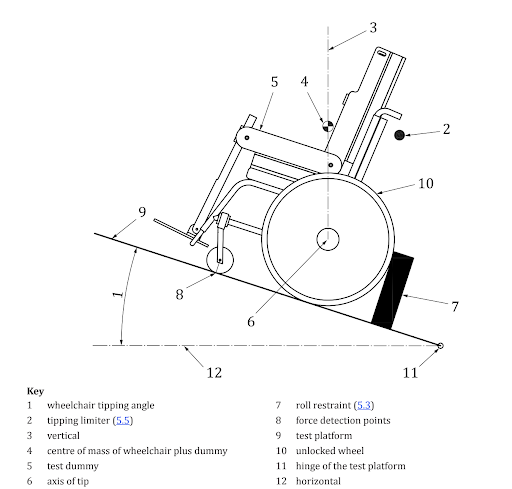Goal of Test: The goal of the static stability test is to ensure stability of the wheelchair with the add-on on a ramp under varying inclination conditions. This test procedure is given by ISO standard 7176-1 referring to P3 [Appendix A]. This test will test for Specification G5 and P12 [Specifications Report].
Procedure:
- Prepare ramp for testing by positioning the ramp horizontally using the car jack.
- Place the wheelchair on the test ramp. The test should be repeated 3 times for a forward (Figure 1a), backward (Figure 1b) and lateral orientation (Figure 1c). The following diagrams depict the orientation for the three different orientations
- Place the roll restraint in front of the wheels located closest to the bottom of the ramp.
- Position dummy in wheelchair at specified location according to center of mass positioning requirements.
- Secure the test dummy using ratchet straps at marked locations on the wheelchair.
- Secure leveling device (or angle measurement device) to ramp near wheelchair.
- Increase the angle of the platform by cranking the car jack until wheelchair tips. Record this angle to the nearest degree.
- Lower the test platform using the crank on the car jack until it is in its lowest position.
- Repeat steps 2-7 to ensure the wheelchair and add-on are tested with the three different orientations. Reference Figures 1a, 1b, and 1c.



Figure 1. ISO diagrams for three different wheelchair positionings [2].
Required Equipment:
- Adjustable Ramp
- Car jack and mating attachment for raising and lowering the ramp
- Ramp
- Test Dummy (eg. a bag of sand)
- Ratchet Straps
- Roll Restraints
- Roll restraint surfaces that contact a wheel shall be perpendicular to the test plane. The height of the roll restraint shall be sufficiently large to prevent rolling of the wheels during testing
- For specific orientations, reference Figures 1a, 1b, and 1c.
- Clamps
- Angle Measurement Device
Safety Concerns:
We are concerned with instability of the roll restraints. These restraints will be properly clamped in place per the specified location for different testing orientations. By ensuring stability, we will mitigate safety concerns as the ramp is raised and ensure valid testing results.
Clearing the area surrounding the ramp is important for bystander safety. We want to ensure that no one gets injured by the wheelchair or any of the setup. We will only have trained individuals touching the equipment and keep bystanders away during testing. The trained individuals will remain at the top of the ramp before and during the test.
Conducted By: Carolyn Pye, Drew Freeland, Emily Eng
Date of Test: 5/11/2021